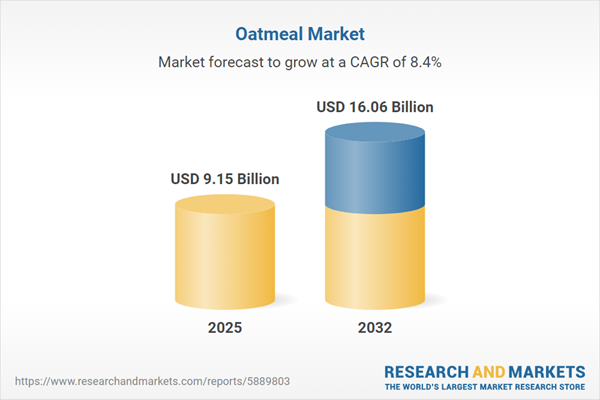Speak directly to the analyst to clarify any post sales queries you may have.
The oatmeal market is experiencing dynamic growth, driven by evolving consumer health priorities, functional product innovations, and increasing demand across diverse global regions. Strategic investment in product diversification and digital engagement is redefining competitive pathways for industry leaders.
Oatmeal Market Snapshot
The oatmeal market grew from USD 8.44 billion in 2024 to USD 9.15 billion in 2025, with projections indicating continued expansion at a CAGR of 8.36%, ultimately reaching USD 16.06 billion by 2032. This accelerated market growth is sustained by consumer preference for nutritious convenience foods, innovation in blends, and the broad integration of whole grains into modern diets. The primary keyword "oatmeal market" is central to industry research and strategic development.
Scope & Segmentation
This comprehensive report details the entire value chain, examining both global and regional dynamics. Segmentation provides actionable insights and addresses the following:
- Product Types: Instant oatmeal, oat bran, oat flour, rolled oats, steel-cut oats.
- Distribution Channels: Convenience stores, drug stores, hypermarkets and supermarkets, online retail, specialty stores.
- Packaging Types: Bulk options, ready-to-eat cups, single-serve packets.
- Flavor Innovations: Chocolate, fruit, nut, plain, savory.
- Health Benefits: Diabetes management, digestive health, energy, heart health, weight management.
- Consumer Demographics: Adults, children, seniors, female and male consumers, with insights reflecting segment-specific buying rationales and preferences.
- Regional Coverage: Americas (United States, Canada, Mexico, Brazil, Argentina, Chile, Colombia, Peru), Europe, Middle East & Africa (United Kingdom, Germany, France, Russia, Italy, Spain, Netherlands, Sweden, Poland, Switzerland, UAE, Saudi Arabia, Qatar, Turkey, Israel, South Africa, Nigeria, Egypt, Kenya), Asia-Pacific (China, India, Japan, Australia, South Korea, Indonesia, Thailand, Malaysia, Singapore, Taiwan).
- Company Analysis: The Quaker Oats Company, Nestlé S.A., Kellogg Company, General Mills, Bob’s Red Mill Natural Foods, Nature’s Path Foods, Post Holdings, Grain Millers, Weetabix Food Company U.S. & Australia, Hain Celestial Group.
Key Takeaways for Senior Decision-Makers
- Consumer focus on functional nutrition and whole-grain wellness is accelerating category development and product innovation.
- Manufacturers are adopting regenerative agriculture and transparent sourcing, meeting rising expectations for sustainability in ingredient selection and packaging.
- Digital commerce and subscription-based models are reshaping consumer engagement, enabling greater product personalization and loyalty.
- Oatmeal flavor profiles now extend well beyond traditional offerings, catering to regional tastes and new meal occasions, further increasing penetration across demographic groups.
- Collaboration throughout the value chain—including partnerships between ingredient suppliers, logistics providers, and research groups—is expediting product launches and substantiating health benefit claims.
Tariff Impact and Operational Adjustments
The 2025 United States tariff measures have influenced the oatmeal market supply chains and procurement strategies. Manufacturers and sourcing teams are diversifying supplier networks and seeking local alternatives to buffer imported ingredient costs. Some companies are investing in nearshoring and substituting select inputs to ensure business continuity and reduce exposure to international freight volatility. These adaptations support supply chain resilience in a shifting policy environment.
Methodology & Data Sources
The research framework combines primary interviews with senior industry leaders and procurement experts, supplemented by secondary data from academic journals, industry literature, and regulatory filings. Statistical modeling, scenario simulation, and qualitative peer review underpin the findings, securing data reliability and actionable insights for decision-makers.
Why This Report Matters
- Senior executives will gain deep visibility into segment-specific demand drivers, allowing for confident investment and product innovation decisions.
- The market research provides a critical assessment of supply chain and regulatory shifts, equipping leaders to optimize risk management and sourcing approaches.
- Insights into technology adoption, consumer trends, and sustainability imperatives enable more agile strategic planning and competitive positioning.
Conclusion
With robust demand, rapid innovation, and evolving regulatory dynamics, the oatmeal market presents actionable growth opportunities. Organizations that align operational flexibility with sustainability and digital engagement are positioned to drive long-term success.
Additional Product Information:
- Purchase of this report includes 1 year online access with quarterly updates.
- This report can be updated on request. Please contact our Customer Experience team using the Ask a Question widget on our website.
Table of Contents
3. Executive Summary
4. Market Overview
7. Cumulative Impact of Artificial Intelligence 2025
Companies Mentioned
The companies profiled in this Oatmeal market report include:- The Quaker Oats Company
- Nestlé S.A.
- Kellogg Company
- General Mills, Inc.
- Bob’s Red Mill Natural Foods, Inc.
- Nature’s Path Foods, Inc.
- Post Holdings, Inc.
- Grain Millers, Inc.
- Weetabix Food Company U.S. & Australia, Ltd.
- Hain Celestial Group, Inc.
Table Information
| Report Attribute | Details |
|---|---|
| No. of Pages | 184 |
| Published | October 2025 |
| Forecast Period | 2025 - 2032 |
| Estimated Market Value ( USD | $ 9.15 Billion |
| Forecasted Market Value ( USD | $ 16.06 Billion |
| Compound Annual Growth Rate | 8.3% |
| Regions Covered | Global |
| No. of Companies Mentioned | 11 |









